Increasing market share is an easier growth strategy for small business-to-business (B2B) companies than chasing new territories or innovating new products.
You can use several strategies to increase market share, like optimizing pricing and improving sales efficiency.
In this article, you’ll learn seven market penetration strategies, why increasing market share matters and how to calculate your current penetration rate.
Key takeaways for market penetration
Market penetration measures how much of your total addressable market currently uses your existing product or service.
Higher penetration directly correlates with profitability, economies of scale and wide competitive moats.
Increase market penetration by refining your pricing, enhancing product-market fit or pursuing sales strategies like account-based marketing.
Pipedrive increases market penetration by streamlining sales processes, centralizing data and increasing efficiencies – try it free for 14 days.
What is market penetration?
Market penetration measures how much your target market uses your product or service.
In other words, it’s how well your product sells.
Market penetration is calculated as a percentage of your total addressable market. Use this metric to benchmark your performance, analyze competitors and find business expansion opportunities.
Market leaders have high penetration rates – think Apple and the smartphone market.
Startups and small-to-medium businesses (SMBs) may have less penetration, but can win a larger market share through a solid market penetration strategy.
Example: A small cybersecurity software startup calculates a 2% market penetration rate. It aims to increase penetration by running targeted LinkedIn campaigns to increase brand awareness and lowering prices to convert more customers.
Successful market penetration leads to more brand recognition and higher sales without launching a new product or entering a new market.
It can also lead to greater market share, a term people commonly confuse with market penetration.
Download Your Sales and Marketing Strategy Guide
Market penetration vs. market share vs. market expansion
Market penetration, market share and market expansion are similar terms with slightly different meanings:
Market penetration measures customer adoption rates within your defined target market. It tells you what percentage of your target market you’re serving.
Market share calculates your revenue as a percentage of total industry sales, so you know how much of the total market you control.
Market expansion is the process of entering new potential market segments, customer segments or product categories. It encompasses strategies for growing beyond your current market.
While increasing product market fit can increase market share and penetration, it’s not a market expansion strategy as it doesn’t increase your total addressable market.
Is customer penetration the same as market penetration?
Customer and market penetration are related but distinct concepts that measure different things in marketing and business analysis.
Market penetration: The percentage of the total addressable market using your product. E.g., if there are one million potential smartphone users in a region and your company sells to 100,000, your market penetration is 10%.
Customer penetration: The percentage of your existing customer base that uses a specific product or service, or the average number of products adopted per customer. E.g., if you have 1,000 customers with 200 using your premium service, your customer penetration for that service is 20%.
Now that you know the difference between all these terms, it’s time to learn why increasing penetration matters for SMBs.
Why high market penetration matters for small B2B brands
Deeper market penetration creates advantages rival companies find difficult to replicate.
It’s why small business leaders often prioritize penetration over market expansion or product diversification strategies.
Here are the full benefits of market penetration.
Increase sales and market share
Greater market penetration means more sales, a bigger market share and a larger company without investing heavily in product development or new market expansion.
That means higher profits. The Harvard Business Review identified market penetration as a key determinant of profitability as far back as 1975:
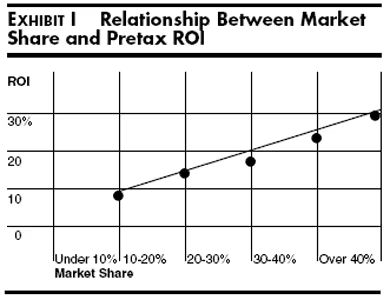
Source: The Harvard Business Review
More recent research by McKinsey finds that a 5% increase in revenue per year results in an additional 3% to 4% increase in total shareholder returns. That’s like increasing your market cap by 33% to 45% over a decade.
Leverage economies of scale
Higher market penetration rates allow you to spread fixed costs like salaries and equipment across more accounts. It lowers per-unit costs and improves profit margins.
SMBs with bigger customer bases often enjoy more supplier bargaining power. You could negotiate better rates with volume discounts to further increase your margins.
In a SaaS business, this could involve negotiating better rates on cloud infrastructure and operational tools like employer of record (EOR) software.
Build a competitive moat
Strong market penetration builds a competitive moat, which Warren Buffett calls the sign of a “truly great business”.
Higher penetration rates create a flywheel model. The more people who use, review and talk about your products, the stronger your word-of-mouth marketing. The result is even more customers without higher marketing costs.
You may even enjoy network effects if you’re a community-based B2B business like Slack and G2. As more customers adopt your platform, it becomes more valuable for everyone and more consumers will be interested in it.
Increase customer data
A bigger customer base generates more customer data. Small businesses can use the data to improve personalization efforts and keep pace with larger, more advanced competitors.
Consumers prefer brands that make them feel understood and unique. Research by Deloitte finds that brands that excel at personalization are 48% more likely to exceed revenue goals and 71% more likely to improve customer loyalty.
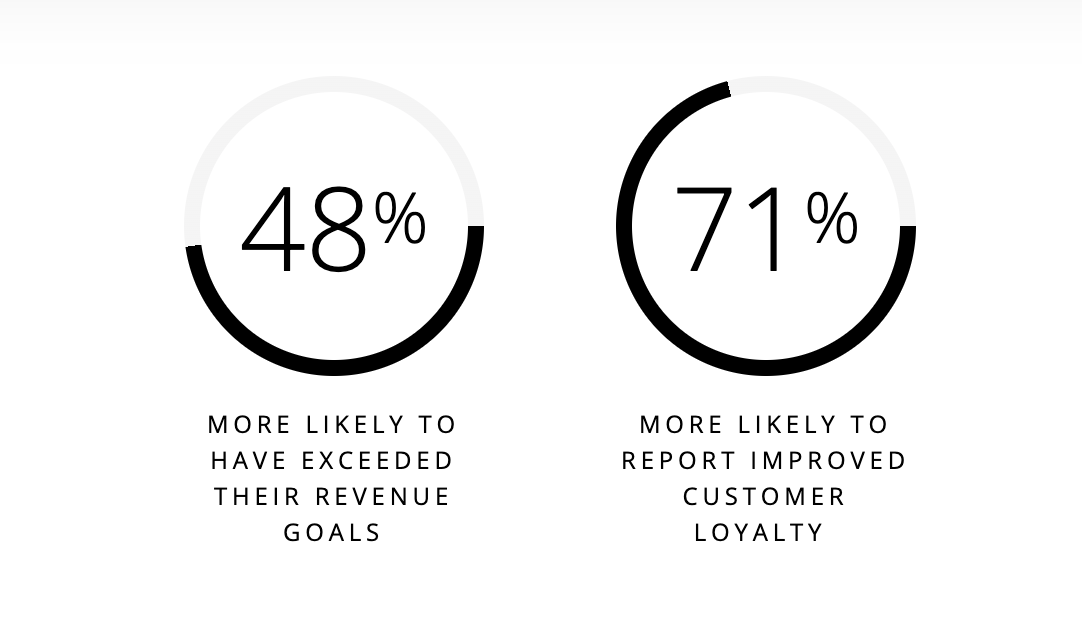
Source: Deloitte
Your data advantage will compound over time. It can lead to even greater personalization efforts, stronger customer success programs and more accurate sales forecasting.
Before you can look at increasing penetration, learn to measure your current penetration rate.
How to calculate your market penetration rate
To calculate your market penetration rate, you must know the number of customers you currently serve (your total sales) and the target market size.
You’ll find the first figure in your customer relationship management (CRM) system and the second in market research reports. Many reports are available from market research firms like Mintel, Statista and IBISWorld.
The market penetration rate calculation is simple:
Market penetration rate = (number of customers ÷ total addressable market size) × 100
Consider an e-commerce software company targeting mid-market retailers with 500–2,000 employees.
If its total addressable market contains 5,000 companies and there are 400 current customers, market penetration equals 400 ÷ 5,000 × 100 = 8%.
Once you have your market penetration rate, proceed to implement strategies to improve it.
7 B2B market penetration strategies
The Ansoff Matrix, a strategic model that helps leaders choose business growth strategies, depicts four main ways to grow a company.
Here’s what the matrix looks like:
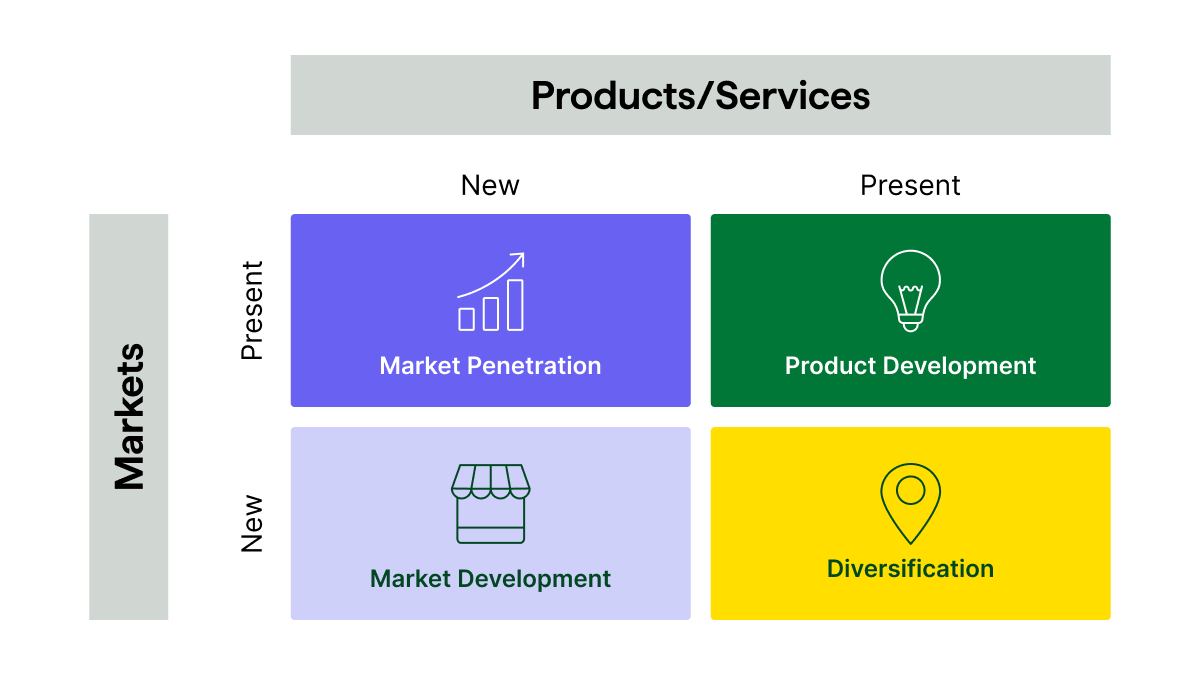
Most businesses view market penetration as the lowest-risk option. Product development, market development and diversification often require significant upfront investments in new ventures without a guaranteed payoff.
It’s a safer bet for small businesses to do more of what works.
Here are seven proven SMB market penetration strategies you can use individually or in combination to win more of the market.
1. Manage everything in a CRM
Centralizing all your sales data into a single platform, like a CRM, makes it easier for sales reps to address your target market.
Your team can access all relevant data in one place, eliminating silos and ensuring consistent and personalized interactions across every touch point.
The result: a faster and more responsive service that prioritizes customers and closes more deals.
Pipedrive’s visual sales pipeline and in-depth customer profiles are a great way for sales teams to find customer information, track deal progression and identify bottlenecks.
Here’s what your team’s sales process could look like in Pipedrive:
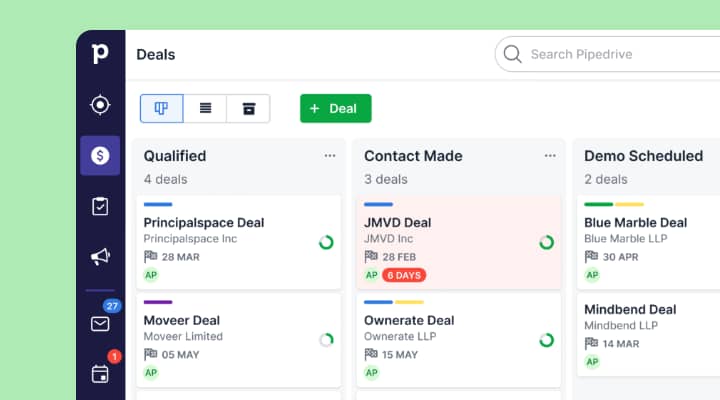
Reps can add notes to customer profiles and refer to them to stand out in future conversations. For instance, if a client loves to travel, a salesperson can make a note to ask about upcoming trips.
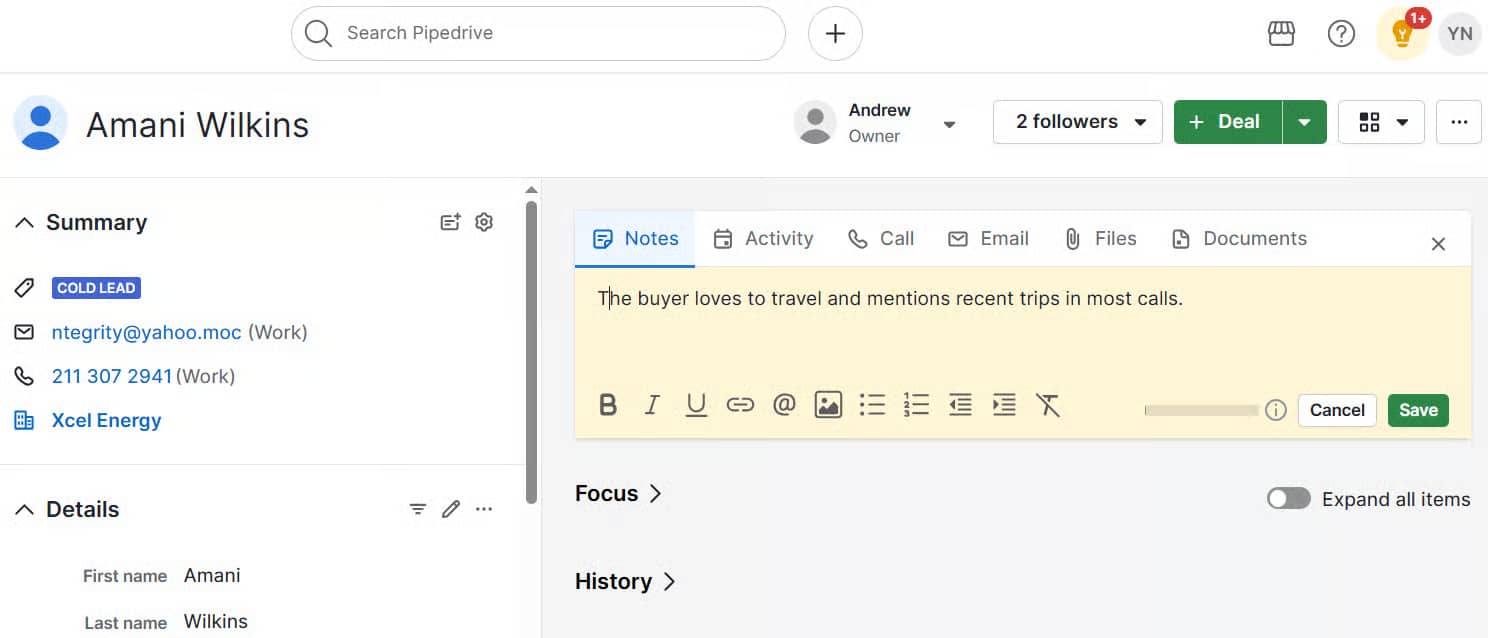
Pipedrive’s workflow automation features let you further streamline processes. You can create triggers that send personalized follow-up emails, move deals along pipeline stages and update customer contact cards.
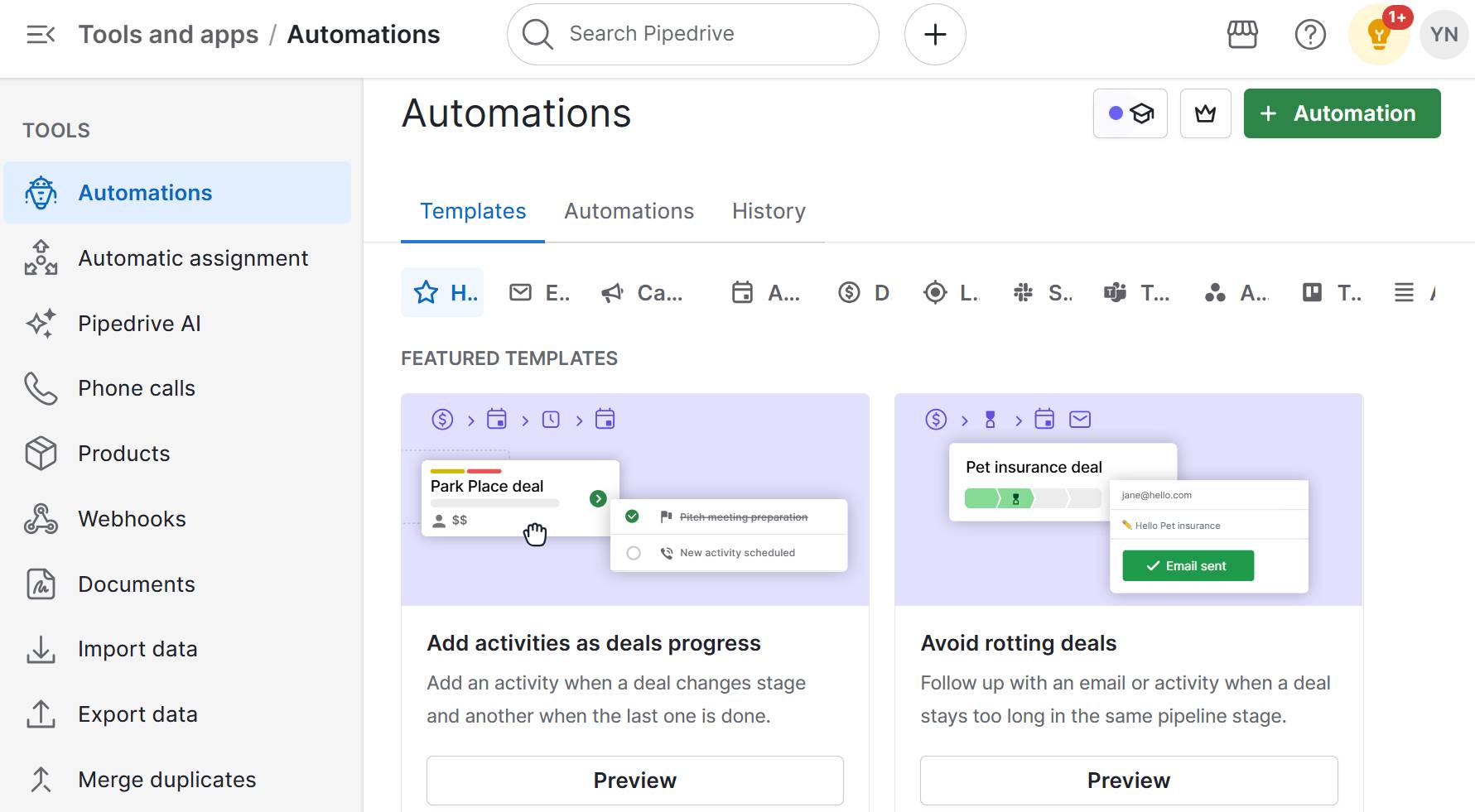
These combined features help sales teams manage more deals at once, improve customer relations and finalize more sales.
Pipedrive in action: B2B lead generation agency Belkin uses Pipedrive to manage over 500 concurrent deals across multiple client verticals.
Since adopting Pipedrive, it has doubled sales effort every year, reduced email creation time from 15 minutes to two minutes and saved 50 hours per week.
2. Optimize your pricing
Pricing is a powerful market penetration strategy that helps you gain market share by undercutting competitors and removing barriers to adoption.
Here are four effective sales pricing strategies to increase penetration:
Penetration pricing | Set a low initial price to quickly attract customers and gain significant market share. The goal is to entice customers away from competitors by offering a better deal, encouraging rapid adoption and brand loyalty. |
Tiered packaging | Create entry-level options that reduce initial barriers while providing upgrade paths:
Pipedrive’s pricing page is an excellent example of this approach. |
Volume pricing | Reward larger commitments from companies with:
For example, a software company charges $20 per user for up to 10 seats, with a discounted rate of $15 per user for teams of 50 or more. |
Market-based pricing | Adjust pricing based on consumer willingness to pay and competitive positioning. For example, a B2B wholesale e-commerce platform with dynamic pricing that changes based on competitor activity, sales trends and inventory levels. |
Zoom’s pandemic pricing strategy shows how you can rapidly gain market penetration.
Real-life example: Zoom made the following pricing adjustments to win more customers:
- Removed the 40-minute meeting limit for primary and secondary schools, but kept it for other free users to maintain upgrade incentives
- Added security features to the free tier in response to privacy concerns
- Kept prices stable for paying customers, despite the potential to dramatically increase revenue
Zoom’s pricing decisions increased market share in a rapidly growing and competitive B2B space. It increased by 367% year-over-year to $882.5 million in Q4 2020 and increased customer retention by over 130%
3. Find and increase product market fit
Better product-market fit increases customer satisfaction and makes it easier to grow.
Sales reps will face fewer objections and convert more deals, faster. Happy customers will tell their friends about a great product, creating organic growth through customer referrals.
Achieving all these benefits requires systematic feedback collection and rapid product development. Start by collecting feedback throughout the customer journey:
Hold individual or group customer research sessions
Run in-product surveys and feedback widgets to gather real-time, contextual input
Deliver automated NPS surveys at key touchpoints
Organize focus groups or beta testing sessions to observe user interactions
Once you’ve collected all that feedback, you’ll need a place to store it.
Pipedrive lets you create a customer feedback tracker to store, review and action customer suggestions.
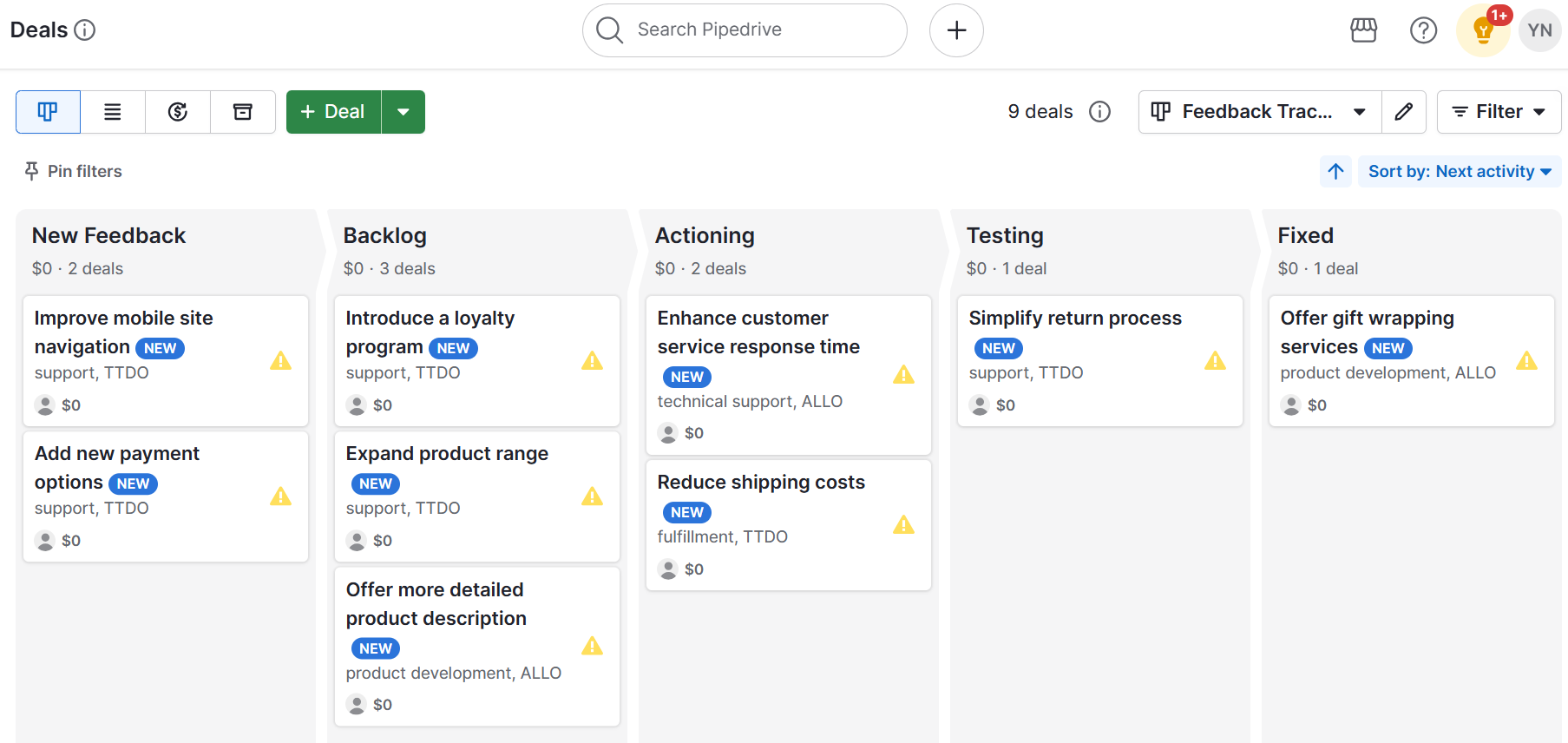
From there, it’s a case of implementing feedback to improve product-market fit.
Real-life example: As a startup trying to find space in a highly competitive market, email client Superhuman stood out by obsessively focusing on a small customer segment: email power users. It conducted over 500 user interviews to understand customer frustrations, then built prototypes to test extensively.
Superhuman held closed beta testing, which required a 45-minute onboarding call to ensure users matched its ideal customer profile. The company iterated rapidly with new features such as AI triage based on real user behavior.
The combination of in-depth research and rapid development helped Superhuman create a premium email experience, valued at $825 million in 2021.
4. Implement account-based marketing to drive demand
Account-based marketing (ABM) is a sales strategy that concentrates sales resources on high-value prospects within your target market.
Instead of trying to sell to everyone, you take a personalized approach that addresses key decision-makers’ unique pain points and goals.
A high-touch service accelerates sales processes, increases deal sizes and boosts conversion rates. Increase your ABM success using the following tips:
Encourage collaboration between sales and marketing. Create a detailed list of high-value accounts that match buyer personas and ICPs.
Find and address the specific needs of each account. Use social proof like case studies or customer stories to prove your platform’s capabilities.
Take a white-glove approach to sales outreach. Use a combination of phone, email and social media to reach decision-makers in a thoughtful and personalized manner.
Track your success using dedicated account-based management (ABM) software. Measure engagement and adjust your strategy.
Data platform Snowflake has achieved remarkable success with its account-based marketing efforts.
Real-life example: In a two-year period before the company’s $3 billion IPO, Snowflake delivered personalized customer experiences to over 2,000 accounts, saw a 75% increase in SDR meetings and tripled the meeting rate for hyper-aligned accounts.
5. Use AI to increase sales efficiency
Artificial intelligence can dramatically boost your sales productivity and sales efficiency. It helps teams close more deals in their existing markets with less effort.
For example, Pipedrive is an AI-powered CRM that helps sales teams automate repetitive tasks, find high-value prospects and create engaging sales messages faster.
Pipedrive’s AI Sales Assistant monitors your pipeline and sales data. It highlights at-risk deals and suggests which prospects reps should focus on instead. Sales teams spend more time on the deals that are most likely to convert as a result.

The AI email writer helps reps create high-quality, personalized emails at scale, including choosing the type, tone and length of content

.
Pipedrive in action: Full-service digital agency Spark Interactive has used Pipedrive’s AI and automation features to grow annual revenue by 12% without expanding its sales teams.
That’s because Pipedrive’s AI features, like Sales Assistant, automate a lot of the extra work. It offers personalized recommendations and timely reminders that help Spark’s sales team focus on the best leads.
6. Run marketing campaigns
A comprehensive marketing campaign increases market penetration by rapidly raising brand awareness and attracting new customers.
Use targeted placements, engaging sales messaging and high-impact offers to stand out and capture more of the market’s attention.
For example, a software company could:
Offer newsworthy discounts or price drops
Run viral social media campaigns
Partner with influencers
These efforts can be costly, but they can significantly accelerate market capture while increasing brand recognition and driving higher sales volumes.
Real-life example: Clothing retailer Gymshark started life as a garage-based startup. To boost market penetration, it ran aggressive influencer marketing campaigns on Instagram and YouTube, partnering with fitness micro-influencers with highly engaged audiences.
Gymshark’s focus on social-first campaigns, viral challenges and limited-time drops rapidly grew brand awareness among its target market, helping it become a global brand valued at over $1 billion in under 10 years.
7. Leverage partnerships and loyalty programs
You can reach more of your sales prospects with the help of partner companies and platforms.
For example, a project management platform might partner with productivity consultants to reach more of its addressable market.
By carefully selecting and supporting these partnerships, you can reach the same customer demographics and grow market share without investing a lot of your own team’s time or resources.
Here are three ways you can expand your distribution channels:
Reseller networks |
|
B2B marketplaces |
|
Referral and loyalty programs |
|
Pipedrive Marketplace is a great example of this strategy.
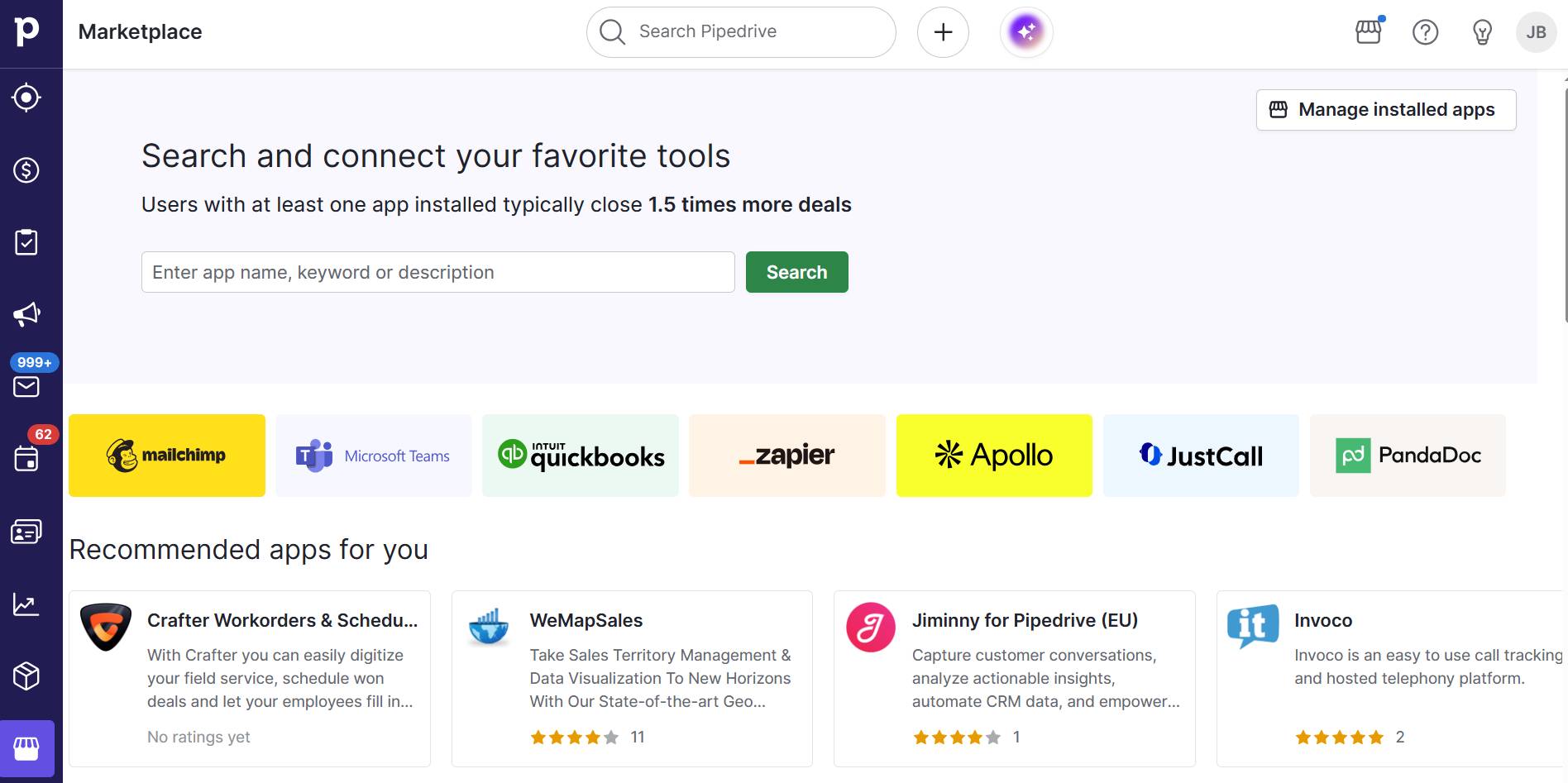
By creating an ecosystem for third-party apps, Pipedrive accesses new target audiences and markets without direct sales effort. The CRM also benefits from increased product adoption, deeper brand loyalty and better platform functionality.
Final thoughts
Market penetration strategies like price optimization and ABM can increase market share without the need to launch new products or enter new markets.
Market penetration strategies can also build brand recognition, stronger relationships and economies of scale for your SMB.
Pipedrive gives you the tools to streamline your sales process, improve your sales efficiency and convert more leads. Start a free trial today to see the AI-powered CRM in action.







